originally posted at https://canmom.tumblr.com/post/716054...
…or Ikuni to his fans. The Utena guy.
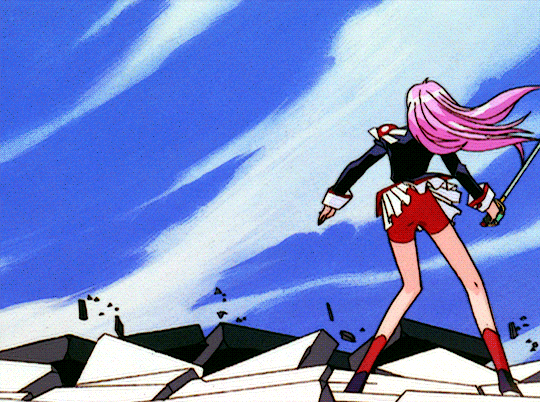
Since the very beginning of this series, Ikuhara’s been someone I’ve been desperate to cover. He’s exactly the kind of weirdo we like around here. And you know how much the Tumblr girlies love Utena.
But only now, at Animation Night 155, is Ikuni getting his due. Why so long? Well, let’s put it like this. Ikuni’s very much a TV guy. Revolutionary Girl Utena is 39 episodes and a movie. Mawaru Penguindrum: 26 episodes. Yurikuma Arashi is 13, as is Sarazanmai.
And if we’ve managed to cram in 13-episode series into this format, it’s always been with difficulty - take Heike Monogatari [AN91], Alexander Senki [AN125] or Houseki no Kuni [AN97]. It generally takes multiple nights. So I thought, that’s fine, we’ll do Adolescence of Utena, the movie, and, um… hmm.
Luckily for us they just made a new Penguindrum compilation movie! Problem solved let’s go!
And with such a long wait behind us, let’s try and do the guy some justice.
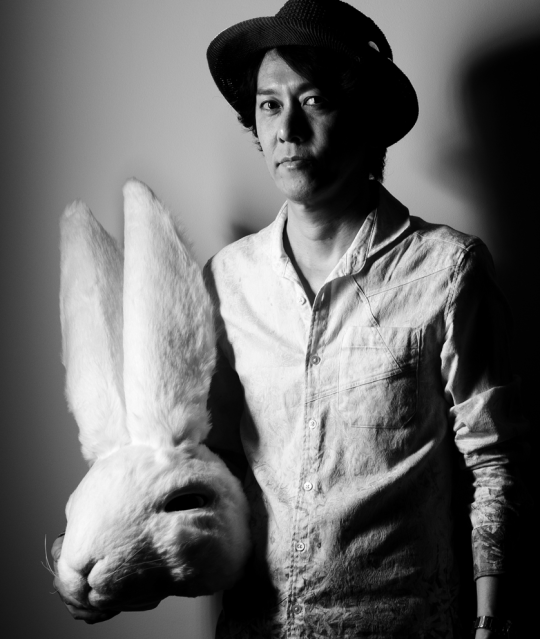
So. Who is this guy with the rabbit? (Picture from his website. Though this is a plain outfit by Ikuhara standards!)
If you were trying to summarise Ikuni’s works… you could probably say something like this: surreal, densely symbolic stories about the difficulties of real human connection. Sort of like the anime version of Lynch. But if that sounds too cerebral, let’s not forget that an episode of Utena involves a character gradually turning into a cow for no particular reason. He’s just as much a goofball who loves to tell lies.
Ikuni came into the business back in the mid eighties, at Toei. [c.f. AN149 for a brief history of Toei!]
So. In the late 70s, Toei had established a powerful niche to themselves in long-running, wildly popular series such as Galaxy Express 999, but most of their work was much less high-profile. Take a glance, see how many of these you recognise - I would guess not many! Hot out of art school, Ikuhara became an assistant director under the wing of Junichi Satō, later well known for shōjo anime such as the avant-garde Princess Tutu (2002-3), or Ojamajo Doremi (1999-2000).
But of course, the most renowned Satō project is Bishōjo Senshi Sailor Moon (1991-7, Pretty Soldier Sailor Moon). Satō directed the first half, and then Ikuhara took the reins for the rest. For Satō it was his debut as a director, I’ll talk more about his tenure on Sailor Moon in just a minute, but first, let’s get a little context about… magical girls!
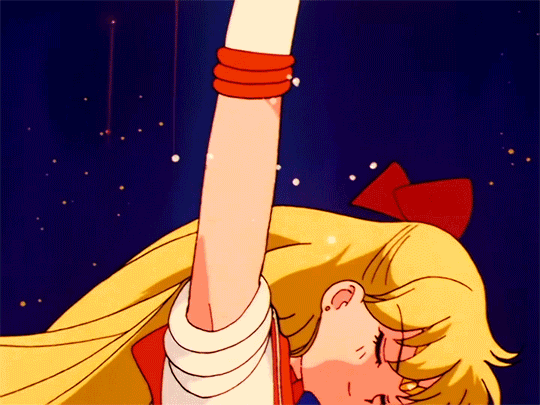
(quick! tell me which sailor this is! you have five seconds)
Magical Girls! 魔法少女 . An ordinary high school student makes contact with a powerful magical being, who may also be a cute mascot character, and agrees to help. Now she can transform: manifest a stylish outfit, gain suitably themed powers, and fight monsters of the week… but she’s got to maintain a double life as a regular student. The henshin (transformation) sequence itself will usually be an extremely elaborate sequence that is played regularly (a ‘bank’ shot).
By now it’s one of the absolutely central anime archetypes, one people are likely to recognise even if they’ve never watched a magical girl show. It’s been parodied, it’s been genderflipped, it’s spun off a dark otaku-oriented variant.
But it wasn’t always so! Everything must begin somewhere. Very quickly reeling this off then… Osamu Tezuka’s 1953 manga Princess Knight is seen as the earliest proto-magical-girl work; Himitsu no Akko-chan (1962-5) as the earliest true magical girl manga with the elements of the genre, and 1966′s Sally the Witch as the big populariser. In the 70s, Toei started producing them in a big way, known collectively as 魔女っ子 series (‘little witch’).
The actual phrase 魔法少女 was introduced in 1980 with 魔法少女ララベル Mahō Shōjo Lalabel. With the economic bubble in full swing, other studios started to join the party - notably AshiPro with Minky Momo, and Pierrot, the studio behind epoch-defining megahit Urusei Yatsura, who entered the arena with Creamy Mami, the Magic Angel (1983-4). Why is she creamy? I don’t know, but that’s her stage name as an idol; the manga was designed to promote an actual idol singer Takako Ōta. This business model proved wildly successful, and even today anime production committees usually include record companies who use the show as a vehicle to promote a song or group. Toei no longer had exclusive hold on the matter of girls, magical.
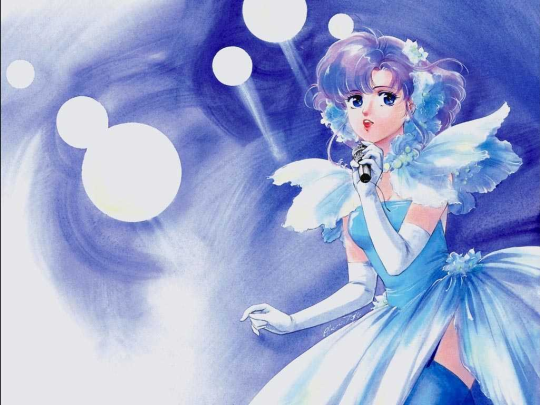
Visually here we’re seeing 80s-style bishōjo, the same as over the fence in sci-fi series such as Macross. Mostly the stories are comedies, following in the footsteps of Urusei Yatsura.
What was missing from the formula at this point? Surprisingly, the henshin sequences! It’s not that magical girls didn’t transform, but they would be more likely to transform into something like an aged-up version of themselves, and the act of transformation wouldn’t be given the same importance. This final ingredient was to be found over in tokusatsu land - Kamen Rider and Super Sentai.
So, that’s where Sailor Moon came in at the beginning of the 90s - first a wildly successful manga by Naoko Takeuchi, and in very short order a TV series at Toei. Takeuchi came up with the idea of fusing the magical girls with sentai: instead of a motorbike-like Rider suit, the girls would get sailor fuku. And that means every magical girl transformation is in a sense a homage to this one.
Sailor Moon tells the story of a girl called Usagi. She’s a clumsy and forgetful audience-identification character - perhaps even to point of being a Huineng-type character? - but she’s informed by a talking cat that she’s the guardian of Earth, soon to be joined by a number of other girls from her area who are, collectively, the Sailor Guardians (セーラー戦士 ). To fight, she activates a magical brooch and, that ^ happens.
Why? Well, the Dark Kingdom is invading! They want to free the villainous Queen Metaria. In past lives the Sailor Guardians fought those guys, and now they need to get back on the job. The forces of the Dark Kingdom (and numerous subsequent enemy factions) arrive in the form of a series of themed villains, much like the villains in a tokusatsu show. Outside of fighting those guys, it’s gentle comedy with a large cast, not so far from the works of Rumiko Takahashi. In fact it’s apparently a fair bit more comedic in tone than the manga, and a chunk of that can be credited to Ikuhara’s influence.
It’s hard to try and summarise the 90s for anime, it wasn’t just one thing. Even as the economic bubble popped, the movies got increasingly ambitious, reaching for more complex emotions and darker themes with incredibly complex animation to match. And to a certain extent, that was also true on TV, by which I mean “Evangelion happened”. But it was also an age of a return to more limited animation. If you wanted to make a TV anime, you had to be smart about using all the tools you could to cut corners. You could keep a bank of reused shots, or for a joke, transform a character into a much simpler caricatured design with more limited animation. At the same time, photography was getting more advanced, and animation techniques were getting more sophisticated.
Even so, a lot of the credit for the art of working effectively in limited animation goes way back to Osamu Dezaki, who back in the 60s and 70s established many of the iconic ‘anime’ techniques. I’ve written about him before back on Animation Night 95, but as much as that covers the history, it doesn’t say a lot about Dezaki’s style. So let me pull in this video, which will helpfully illustrate the important examples…
The relevant period is when Dezaki directed on Aim for the Ace! (エースをねらえ! Ēsu o Nerae!) - where, in contrast to his earlier work which was comparatively cinematic, he started to push in a more theatrical, abstracted direction, prioritising conveying emotion over realism. Still frames (with the famous ‘postcard memory’ effect), simplified background details framed to draw attention to the important stuff, repeating an important shot multiple times - oh, that’s just Utena, huh? And while Dezaki influenced just about everyone, but for Ikuhara, he’s a massive touchpoint.
Designs were also changing - in contrast to the rounded bishōjo of the 80s came more angular and blocky designs. Take Slayers for example:

Hold onto that thought because we’re going to talk about Utena in a minute. Sailor Moon didn’t go quite that far, but Kazuko Tadano’s designs were very effective in conveying a lot of appeal in quite simple shapes. Usagi in particular has an instantly recognisable hairstyle. But it’s also a style very amenable to simplification.
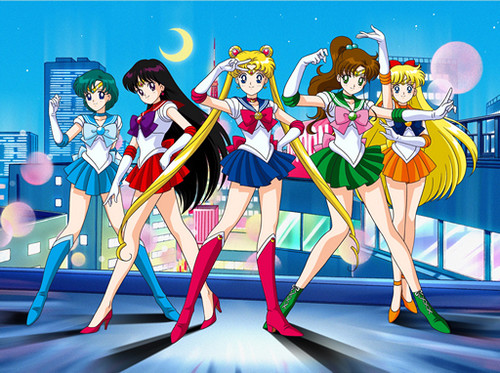
TV anime in this period ran long. Nowadays, the norm is one cours (‘cour’ if you’re not feeling pedantic) of 12-13 episodes, sometimes not even that. Back then you could easily see counts in the 50s or even hundreds. Such is true of Sailor Moon: crazy popular in both Japan and, in its heavily localised dub, America, and with a premise flexible enough to run for years. In the end it racked up some 200 episodes and several movies.
The Ikuhara period starts with the Sailor Moon R movie in 1993, then the series proper starting mid Sailor Moon R and then Sailor Moon S in 1994. Not sure which episode he took over, but S begins at 90. This is a post about Ikuhara (no, really!) so we should ask, how did Sailor Moon change once he took the reins? Let’s have a look at some of his favourite themes, as they appear in the Sailor Moon R movie, based on his own notes…
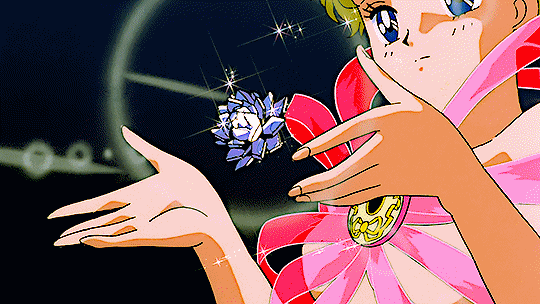
- Lesbians - Not so much in the R movie, but once S gets going… big controversy! Sailors Uranus and Neptune were a couple whose dynamic was one of the most popular in the show, but this would be heavily censored in nearly every localisation, notably the American one which made them cousins.
- Flower imagery - Ikuhara decided to set his first project as director in a botanical garden, naturally.
- Lost connections, the distance between people - to quote the linked blog…
Ikuhara compares the reunion between Fiore and Mamoru with that of being stuck on a train in-between stations when suddenly you notice you’re standing next to an old friend you haven’t seen in years.
At first you’re both excited to see each other again and kill the time by catching up on each other’s lives. But eventually you run out of things to say, and the conversation just kind of dies off, leaving you both standing there in awkward silence.
- Creative editing, use of music - 18 second long scene of Tuxedo Mask getting stabbed? Musically timed fight? Mm.
- Darker themes - let’s watch the girls incinerate a field of flower monsters! At one point Usagi would nearly die! Ikuhara tried to keep it ‘fun’ and lighthearted, but just couldn’t do it, he says. Nothing on the level of where his later work would go, but definitely harsher than your average episode.
- Vaguely hinting that some element is key to understanding everything, and then refusing to elaborate further - oh yes.
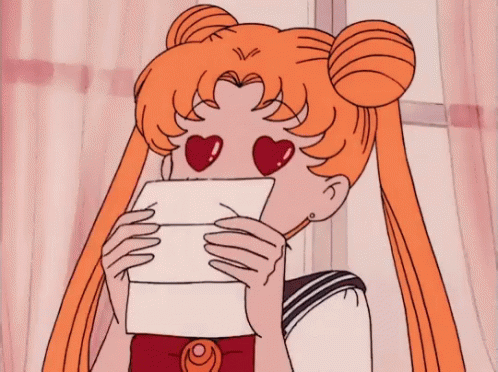
Which isn’t to say that Ikuhara’s Sailor Moon instantly became Utena. Rather, the seeds of his interests as a director, the sort of emotional arcs he’d like to portray, were there. I regret that I can’t really comment in much detail on what Ikuhara did in his actual run on the TV series - I’m sure I have some big Sailor Moon fans here who could fill me in and tell me if I’ve described anything wrong.
Working on Sailor Moon, in any case, also got Ikuhara used to technical elements that would become part of his stylistic fingerprint. We mentioned the transformation sequence, the elaborate bank shot with accompanying music that would recur in nearly every episode. I am less sure about other Dezaki-esque elements, like jokes based on repeating the same sequence with minor variations.
Eventually, Ikuhara’s run on Sailor Moon would come to an end. The final arc of the show saw the Sailor Guardians facing… themselves, from a distant bad future. But for that final season, Ikuhara had already stepped down. Where did he go…?
You see, Ikuhara chafed under the creative restrictions placed on him by Toei. Turning down an offer from Anno to work on Eva(!), he set off to found his own group, Be-Papas, along with…
the famous shōjo manga artist Chiho Saito, animator Shinya Hasegawa, writer Yōji Enokido, and producer Yuuichiro Okuro
and before long also recruiting composer J.A. Seazer, known for his work with avant-garde dramatist-filmmaker-writer-poet Shūji Terayama - another big influence on Ikuni, incidentally. What did Be-Papas make? Just one anime, after which they disbanded. That anime was… Albert Ei-
That anime was Utena.
Oh man. This is the one.
少女革命ウテナ - Shōjo Kakumei Utena. In English, Revolutionary Girl Utena. Now the time has finally come to write about it, I’m nervous. Could I possibly do justice to Utena in a single blog post? Is that why I spent so long writing about Sailor Moon?
Let’s start with the aesthetic: French Revolution-esque outfits that would be comfortable in Rose of Versailles. A school made of white stone; architecture that is strange, avant-garde. Roses. So many roses oh my fucking god. It draws heavily on the Takarazuka Revue, which I wrote about previously on Animation Night 92 in the context of Ikuhara’s protege Tomohiro Furukawa.
Utena is about a girl called (wait for it) Utena, who attends a school of sorts called Ohtori Academy. But it’s a school only in a fairly abstract sense - it’s more like a palace. She wears a distinctive masculine uniform, and shortly after transferring in, discovers a mysterious underground duelling society who go to a strange abstract battle arena outside of school hours. There, they attempt to strike the rose from the other duellist. The winner of the duel gains custody of Anthy Himemiya, the ‘Rose Bride’. At some point, whoever possesses Anthy will gain the nebulous power to ‘revolutionise the world’. With me so far?

Utena walks in and immediately wins her first duel, establishing an initially frosty relationship with Anthy. But the White Rose duellists won’t take this lying down. Over the first series of episodes, we learn about each of the duellists and their motivating conflicts, culminating in an attempt to defeat Utena. (She walks up the stairs every time.) They lose every time, but the point isn’t really about whether Utena will win or not - it’s about introducing us to a collection of fucked up guys, and then making them even more fucked up.
But it’s not all high drama. A lot of Utena is just straight-up antics, which is to say, just about any time Nanami is on the screen. There’s a greek chorus of shadow girls who comment on the events of the episode. The broad strokes are hard to miss, but the subtler, more obtuse stuff is the sort of thing that can get you into an almost endless rabbit hole of analysis. Don’t take things too literally! You could probably call it at least a little Brechtian in how much it foregrounds its own artifice.
After Utena’s defeated just about everyone at the White Rose, the Black Rose arc introduces a new element. Now, characters from beyond the duelling circle will go down an elevator to guy who renders a fucked up sort of anti-therapy which will motivate them give into their worst impulses and have a go at Utena. Utena, meanwhile, is harbouring a complex where she needs to live up to an ideal of fairytale prince following an incident from her childhood - and oblivious to what’s actually going on with Anthy.
Then at last Anthy’s brother Akio shows up - the actual prince from the upside-down castle in the sky that represents the power to revolutionise the world, and the architect of the monstrous system. It turns out he’s been incesting Anthy, that she’s complicit in all his shenanigans (guess who was behind the Black Rose thing). Moreover, Utena is pulled in to Akio’s orbit, an ugly, abusive relationship… that is conveyed mostly through visual metaphors involving cars.
The finale is… complicated to explain. But it gives us one of the most iconic pieces of cinematic lesbianism ever animated, as Utena reaches for Anthy, refusing to be pushed away (by stabbing) or let Anthy remain in her state of self-inflicted pain, and they are able to escape the academy and its system, at the cost of being separated. What future they have outside the academy is left unspoken…
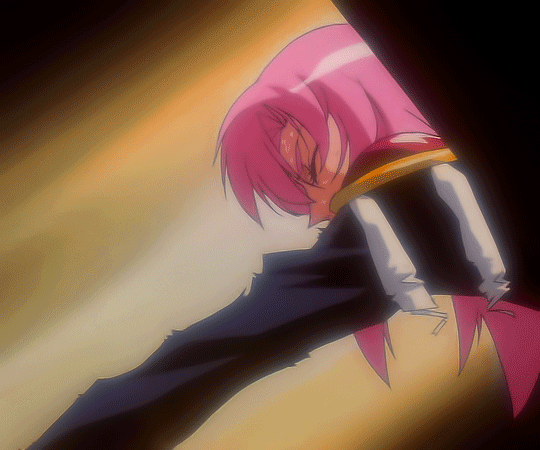
And that’s just scratching the surface. If you ask the hardcore Utena fan, just about every element of every shot is dripping with meaning. You can’t take everything too literally, but you definitely have to take some portion of it literally or you don’t have a story and characters at all.
Visually, the characters in Utena are designed by Shinya Hasegawa - and as much as they are recognisably ‘90s’, they really push it. People are long and faces - noses and chins especially - are pointy. Characters tend to be reserved and stoic in their facial expressions, unless they’re Nanami, in which case all bets are off. Animation-wise, JC Staff did the work under Be-Papas’s direction - and as much as it uses limited animation for effect, it’s really got the goods, especially in the duel sequences and the bank shots (Utena climbing the stairs? Not CG!).
Did you know Yoh Yoshinari was on it? I didn’t until today! So too was Mamoru Hosoda.
Remarkably for such a deliberately challenging show Utena was pretty successful! This was the era between Eva and Lain: it was an excellent time to be making something really experimental and push those genre boundaries. (One thing I don’t really know is how Utena got funded in the first place, but all the big names attached to the project probably gave them some pull.)
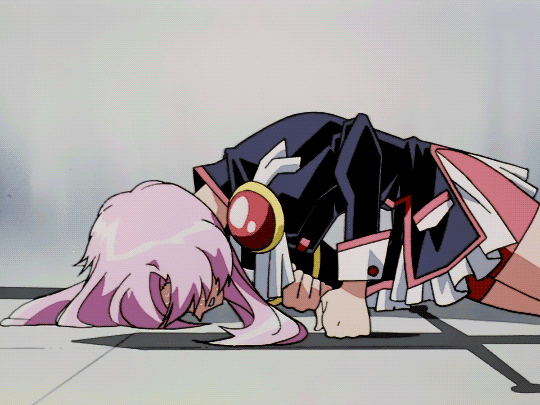
Alongside the anime came a manga by Saito - but neither is really an adaptation of the other, they’re just two different interpretations of the same general concept and premise, produced at the same time. And in fact, Ikuhara and Saito clashed heavily over the direction of the series, particularly in regards to whether the relationship between Utena and Anthy should be presented as romantic. Saito did not believe that shōjo audiences would be on board with the yuri, but Ikuhara refused to back down. (Saito eventually changed her mind.)
With all this success, they went ahead to make a movie. Now, usually a compilation movie of a successful TV series will cut out down the story to fit the runtime, reanimate a few scenes and call it a day. But this would be all but impossible with Utena, which is so tied to its episodic structure and use of repetition. And in any case, Be-Papas had bigger ambitions!
The film would be titled 少女革命ウテナ アドゥレセンス黙示録 Shōjo Kakumei Utena: Aduresensu Mokushiroku, literally Revolutionary Girl Utena: Adolescence Apocalypse, though in English it’s usually given the shorter title Adolescence of Utena. It is kinda sorta a condensed version of the series at first… and then in the latter half it goes completely off the rails. This time Akio is long dead. And he’s not the only one! It ends with this absolutely nuts sequence where Utena turns into a car to drive Anthy out of the academy, pursued by Shiori, who also turns into a car. I still can’t say I really understand it, or how it relates to the ‘car is a rape metaphor’ role in the TV series? But it looks beautiful.
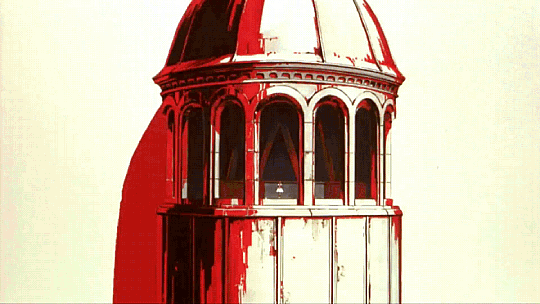
Compared to the series, the movie features the expected higher drawing counts and flashier animation… but the really novel aspect is the architecture. This movie goes absolutely wild with it: the Ohtori Academy this time is far stranger and more intricate, looking less like a regular old European palace and more like something dreamed up by the Russian avant-garde.
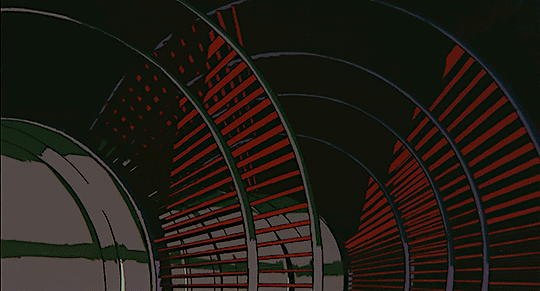
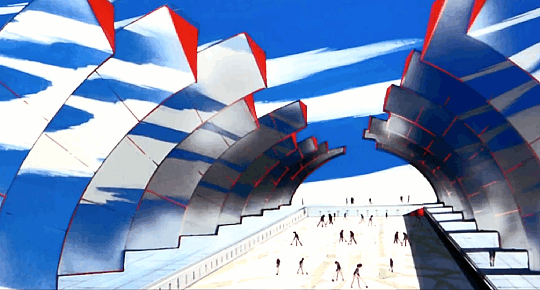

It’s less of a summary of Utena and more of a companion piece. Seen on its own by someone who’s not familiar with either… I’m not sure how it would come across! Maybe you’ll just think I’m insane. Maybe you’ll be right.
So, some 3000 words into this post, I’ve finally told you the first movie we’ll be watching! That’s right: we’re going to jump in at the deep end and enjoy Adolescence of Utena. You don’t need to have seen the series.
After Adolescence, Be-Papas disbanded, as if following Monsieur Dupont’s injunction that radical groups must exist for a single purpose and then disband. Ikuhara left anime for a long time, like twelve years. He wasn’t entirely cut out from the industry, occasionally dropping in to storyboard an episode or two (for example, Episode 2 of Diebuster, or the OP to yuri series Aoi Hana). But for the most part, he turned his attentions to other mediums.
In that time he published a shōjo manga, which was poorly received for being a lot more conventional than Utena; he also wrote a novel called Schell Bullet which, get a load of this…
As a result of gene manipulation, society is segregated by genes into “Majors” – intersex humans who maintain a monopoly on stronger genetic material – and lesser dual-sex “Minors”. (Ikuhara stated that he chose to make the Majors intersex because he wished to create “a race which combines the good parts of both women and men.”[1]) Protagonist Ors Break is hired by the intergalactic trading company Balt Liner Corporation to pilot a schell, a bio-organic mecha, by claiming to be a Major. When the truth of his Minor status is revealed, he comes to an agreement with his superior, a Major named Delbee Ibus, to continue working for the organization.[1][2]
…and another serial novel called Nokomono to Hanayome, described as ‘Lolita hardboiled’ (I believe as in ‘Elegant Gothic’ rather than as in ‘Nabokov’s novel’). This last was a precursor to Penguindrum - animal costumes, the a story about the 1995 Tokyo sarin gas attacks.
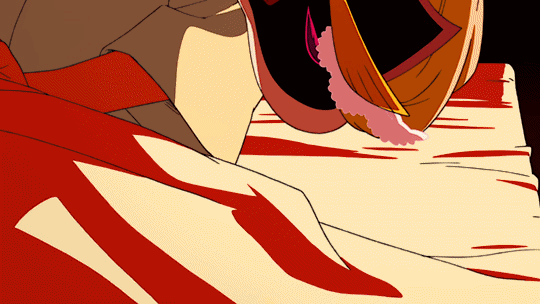
In 2011, Ikuhara came back to anime. Why? And why did he leave in the first place? itsamystery.jpg. In any case, his new project was… Mawaru Penguindrum. It’s about, I guess you might say, the abandoned children of cultists who connect to a supernatural penguin being through a hat. But honestly it’s even tougher to attempt to summarise than Utena. There’s a “child broiler” involved. That’s just the start. And this post is already very long.
So, it’s time to split it. You’ll be able to read more about Penguindrum tomorrow (or later today, if you’re also staying up insanely late in the UK).
Animation Night 155, in its cosy new Sunday timeslot, will be running (if all goes according to plan) at 8pm UK time. That’s about 13 hours from the time of this post. The plan will be to watch Adolescence of Utena and the two movies of Re:cyle of the Penguindrum, for a total of about five and a half hours. (Sorry Sailor Moon fans! I’d really like to squeeze in the R movie too, but I underestimate how long Penguindrum is in movie form. We’ll find another day to do Sailor Moon though!)
If you’ve read all this so far, thanks so much! I’ve wanted to do a proper Animation Night on Ikuhara for ages, and there’s so much I can write about. So far it’s all history, but we wanna do some analysis too. For now… hold on tight.
Good morning Ikuhara fans! Let’s pick up where we left off! We’re about to talk Penguindrum.

I’m gonna start with the name… 輪るピングドラム Mawaru Pingudoramu. Literally, revolving penguindrum. Except… that’s a funny way of writing 回る (to revolve), isn’t it? If you look 輪る up in a dictionary, you find precisely one entry: Mawaru Penguindrum. The kanji 輪 means circle, ring or loop. It is not normally read ‘mawa’. So Ikuhara’s up to his tricks again…
The story starts out straightforwardly enough. Three siblings, Shoma, Kanba and Himari are living together in a ramshackle house, their parents strangely absent. Himari is severely ill, and the brothers extremely concerned. But she’s discharged from the hospital, everything’s fine, right..?
No.
They go to the aquarium and she dies.
But a tacky souvenir penguin hat from the gift shop comes to the rescue! The hat rescues Himari, and when she wears it, she assumes the identity of the ‘Princess of the Crystal’, who’s straight up a dominatrix, existing in an abstract iconographic space along with a big old robot. The Princess tells the brothers that in order to save Himari’s life, they must acquire a macguffin called the Penguindrum. The first step is to spy on a girl called Ringo. To help, they get three mischievious little penguins, visible only to the siblings.
What’s so important about Ringo? Well, she was born on the day that her sister Momoka was blown up by a terrorist attack on the subway, and imagines herself to be Momoka’s reincarnation. And she possesses Momoka’s diary which ostensibly lays out the future, motivating her to try to become Momoka - notably by stalking and attempting to get with with Momoka’s teacher. From there things get really chaotic, with schemes bouncing off schemes; the siblings attempt to intervene to stop Ringo and Ringo goes to increasing lengths.
Around episode 9, the show shifts gears from messed up antics to the core emotional arc. We introduce a man named Sanetoshi, who exists in a strange extradimensional library space which seems to hold Himari’s memories. Sanetoshi’s agenda isn’t immediately clear, but he seems to have some role in bringing about this entire situation.
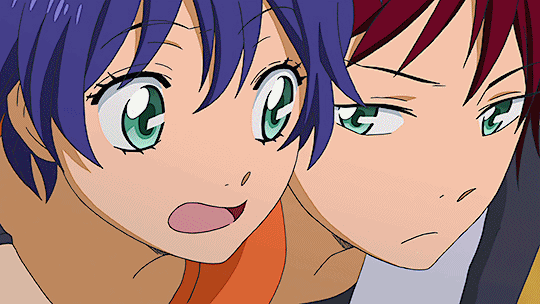
And then around the halfway mark, at last we learn the inciting incident behind all this. The three abandoned siblings are not biological siblings - rather, their parents were all involved in carrying out the terrorist attack which killed Momoko, modeled after the 1995 Tokyo subway sarin attack. From there, things start to get increasingly abstract and the social commentary kicks up a notch. We introduce concepts like the ‘child broiler’, a place where unneeded children go to disappear. Shouma and Kanba rescued her, and now Shouma blames himself for everything she suffers since. Events in the past are revealed and weave together with the present in classic anime style.
So. History tangent time. This information isn’t really necessary for understanding Penguindrum, but it might be interesting! If you don’t wanna read about shinshūkyō and Aum Shinrikyō, scroll down to the penguin.
A little bit of info about Japanese cults and Aum Shinrikyō
Since the mid-19th C., the period of rapid modernisation, Japan developed a large number of ‘new religious movements’, or 新宗教 . At this time, there was a lot of religious turmoil. Buddhist monasteries lost their traditional protections, while the government started formalising the a Shinto-Buddhism syncretism as the official state religion. A number of charismatic religious leaders were able to form new movements such as 天理教 , 黒住教 , and 大本 - borrowing heavily on Shinto but creating their own spin. Despite suspicion from the government, it was not able to suppress these religions, but they persisted.
World War II happened. In the aftermath, the demise of State Shinto created a kind of religious power vacuum. Christian missionaries - notably the Jehovah’s Witnesses - flooded in from America, and more and more new religions were founded based on the Buddhist-Shinto palette. Certain Shinshūkyō became somewhat integrated with the government, with the largest ones using their funds and command over their membership to back up the LDP’s nearly-unbroken rule. If you heard about Shinzo Abe getting assassinated last year, it was due to his association with the Moonies, a Korean Christian cult that bears a lot of similarity to the Shinshūkyō.
So these new religions continued to be founded throughout the 20th century. The largest, the Buddhist movement Sōka Gakkai (founded 1930) expanded rapidly, now claiming twenty million followers, enough to give its political party Komeito the position of junior partner in coalition with the LDP. Which is nuts. The population of Japan is only like 120 million, so that’s like 1 in 6 people following a cult that was invented in 1930.
And while a lot of these shinshūkyō are not so different from more traditional religions, and primarily notorious for shady wartime ties and scamming money out of people… some of them were more like extreme apocalyptic American cults like Jonestown. Happy Science for example is a far right cult founded in 1986, mostly known abroad for funding a bunch of anime movies. But the worst is Aum Shinrikyō. Followers of Aum - ostensibly acting on their own, the organisation survives today under the new name ‘Aleph’! - launched a coordinated attack in 1995, releasing the nerve agent sarin into subways as well as crashing a car into people. Their motivation was to hasten the apocalypse and the eschaton that would follow, and to save the people they killed from racking up bad karma.
At the outset, Aum was popular among students; it leaned on sci-fi novels (notably Asimov’s Foundation series) and anime and manga stories to attempt to draw people in. It made extravagant promises of self-improvement, and fielded a political party (without much success). It sounds a lot like Scientology. And much like Scientology, the organisation routinely pulled some horrific shit behind closed doors, and a couple of murders - one of a member who tried to leave, one of an anti-cult lawyer. They plotted further assassinations. But they wouldn’t stop there. By 1991, they started plotting the subway attacks and stealing uniforms; in 1993 they tried a biological attack using anthrax, without success, and turned to manufacturing Sarin; they carried out a successful Sarin attack in the Matsumoto Incident and managed to get away with it for long enough to do it again. Finally in 1995 they carried out the subway attack, killing 13 people, seriously injuring 54 and affecting many more. This time, the members of the cult were rounded up, arrested, and many of them eventually executed.
You can probably imagine how much this shook Japan. This sort of shit hadn’t happened since like, the 70s. The worst part was perhaps that… it doesn’t make any fucking sense. It’s not some sort of external enemy with a comprehensible grievance. There was not even a political vision they were trying to seize power and build, just weird pseudo-Buddhist eschatology. You’d be left wandering, what could possibly motivate people to go to such extraordinary lengths just to murder at random?
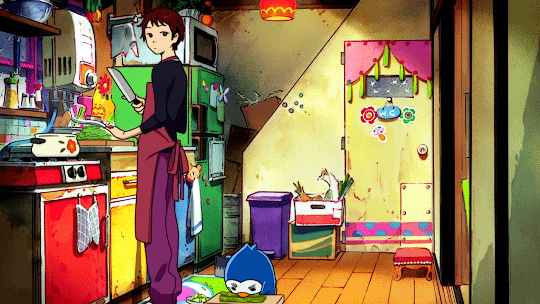
Penguindrum isn’t exactly an anime that’s ‘about the subway attacks’ in a literal sense. It deals with the subject obliquely, by centering its story - as wacky and fantastical as it is - not on the attacks themselves, but on the lasting impact and the sort of circumstances that would give rise to such a nihilistic worldview. It portrays a web of extremely messed up relationships. The central story is about the struggle of the two brothers to save their sister, and how it’s inevitably more complicated than that.
And I’m sure I’m not doing it justice. It’s been years, and I’m really looking forward to refreshing my memory tonight.
So, Mawaru Penguindrum landed in 2011 to solid success. The animation took place at Brain’s Base; they would work together again down the line under their new name Lapin Track on Sarazanmai. The style is much more modern, with a strong sense of colour, and it heavily foregrounds very modern visual design that calls to mind the ‘superflat’ movement’s brief flirtation with anime; there are some striking motifs like the ‘mob’ characters being drawn as extremely abstracted figures like you’d see on a bathroom sign which became a recurring part of Ikuhara’s style. Like Utena, it is a blend of gut-punch heavy stories about the failure modes of human relationships and equally really goofy comedy.
I don’t have time to write about Ikuhara’s subsequent works, Yurikuma Arashi (roughly ‘Lesbian Bear Storm’) and Sarazanmai (not actually a word). Since they’re shorter, maybe I’ll even end up scheduling them down the line, we’ll see.
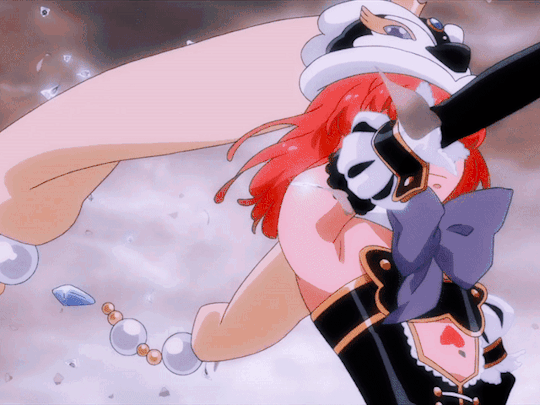
And why Penguindrum now? To celebrate the tenth anniversary of the series, the studio Lapin Track - successor to Brain’s Base - decided to edit it into two compilation movies, with some freshly animated new sequences, under the title Re:cycle of the Penguindrum. Ikuhara returned to direct, Lily Hoshino returned to design the characters, etc. etc. That dropped last year, and in the last couple of weeks, it finally got a BD release I can access. I have no idea if compressing such a long TV series into two movies will be at all comprehensible - it was a bit too extreme for Gurren Lagann - but we’ll see. I’m looking forward to experiencing Penguindrum again.
So. I’m past the time I originally announced, we’d better get a move on! Animation Night 155 will be going live right now at twitch.tv/canmom - movies will start in about 20 minutes - and I hope to see you there! This should be one to remember!!
Comments